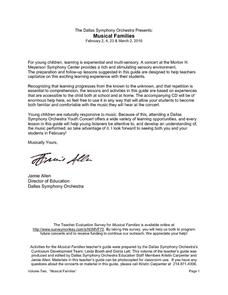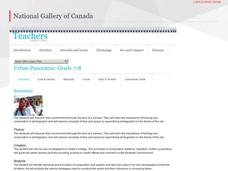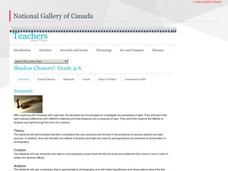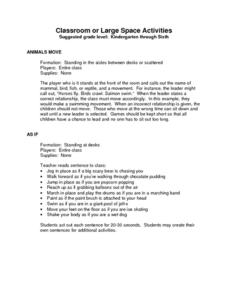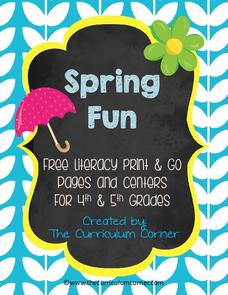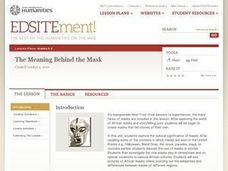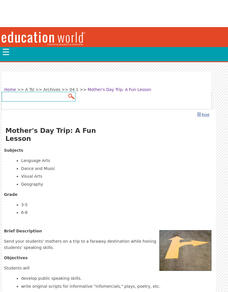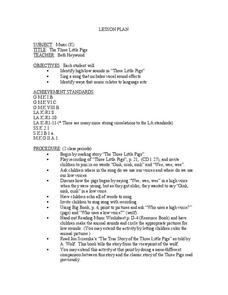National Gallery of Canada
Make a Pinhole Camera
Introduce your class to photography by asking them to construct their own pinhole cameras. After putting together their own devices, pupils take and develop pictures and analyze the results. The plan provides step-by-step instructions...
Dallas Symphony Orchestra
Musical Families
Planning a trip to the symphony? Prepare first-time attendees for the experience with overheads that identify the roles played by the concertmaster, conductor, musicians, and even the audience. The musical families are introduced and...
National Gallery of Canada
Urban Panorama
How can a photographer use images to represent a topic? Over the course of three days, learners discuss various photographs and practice their picture-taking skills with an outdoor, panoramic photography session. They use the images to...
National Gallery of Canada
Shadow Chasers!
Experiment with light and shadow with a photography lesson. Learners first view several artistic photographs. They then play with different levels of light and various objects, eventually putting together compositions and taking pictures...
National Gallery of Canada
Being a Photojournalist
Tell a story with images. Learners view several photojournalistic photos before agreeing on a message to convey with their own photo stories. In small groups, they take and select photos to include in their final project.
San Joaquin Valley Air Pollution Control District
Classroom or Large Space Activities
The 24 activities detailed in this packet are designed to get kids up and moving with a minimum of chaos. A great resource to have on hand for drama classes and content courses.
Into Films
Filmmaking Guide
Pixar, DreamWorks, Disney Studios. Prepare your primary graders to become the next generation of film makers with a guide that encourages kids to explore the possibilities of script writing, lighting, sound, editing, and post production...
Curriculum Corner
Spring Fun Literacy Centers
Looking for spring-themed literacy centers? Look no further because here is a resource packed full of literacy skills practice, including spring verbs, ABC order, spring synonym match, spring phrases, abbreviation match, and a sentence...
Curated OER
The Meaning Behind the Mask
Students explore the world of African masks and storytelling. They create masks that tell stories of their own.
Curated OER
How Do you Feel?
Students discover how moods and perceptions can be affected by colors. As a class, they create their own color wheel and identify primary and secondary colors. They draw their own cool and warm color mosaic and discuss how each one of...
Curated OER
Gallery Walk
After reading Mowgli's Brothers, each third grader will choose an animal and write a poetry, in couplet form, for that animal. Then, they complete a black-line drawing of their animal. Consider having learners post both of their finished...
Curated OER
Mother's Day Trip
Help your class develop their public speaking skills. They write original scripts for informative infomercials, plays, or poetry. They work to present their information with purpose.
Curated OER
Coming to America
Students present tableaus showing scenes from The Memory Coat, a book about immigration. For this tableau lesson, students examine the cover of the book and make predictions about what is happening and who the people are. They create...
Curated OER
Pathways to the Future
Students draw a pathway and create a movement phrase along that same path using specific movement vocabulary. The phrases are performed in class and rubrics are used for assessment. Meets State standards for the arts.
Curated OER
Slide-Tape Dramatization as a Way of Teaching Literature
Students select one song and write the lyrics on the blackboard. They segment the lyrics into meaningful phrases or sentences and visualize each unit of meaning to convey the message of the song. They select a different song and act out...
Curated OER
Rice Wreaths
Students create rice and glue holiday wreaths in this Art lesson ideal for the 1st or 2nd grade. The lesson can be adapted for older or younger students and includes an ingredient list and step-by-step directions for siccessful...
Curated OER
Computer Aided Cubism
Young scholars engage in a study of the artistic style of cubism with the integration of technology to aid them create a unique work of art. They are shown the works of Picasso and Braque in order to serve as examples to create a context.
Curated OER
The Three Little Pigs
Students identify high and low sounds in the "Three Little Pigs" song, sing a song that includes vocal sound effects and identify ways that music relates to language arts. Before singing the song, they have listened to the teacher read...
Curated OER
One Nation - Many Voices
Students examine art from various cultural backgrounds across Canada. They examine and analyze artworks illustrating various cultural groups. They explore the diverse nature of their community. They construct a visual map of their...
Curated OER
The Looking Glass
Sixth graders investigate the intention behind artists' works and contemplate the notion that art mirrors life. They respond orally and in writing to a painting and recognize that seeing the whole picture can offer a different ...
Curated OER
Creative Communication
Students create art works in both visual and written form. They explore how we develop and record our ideas. They create their own sketchbook or journal using simple book making techniques and use the book they created to record ...
Curated OER
Sea-ing More Clearly
Students explore historical importance of fish as food source, examine works of Robert Harris, create their own fish, and compose accompanying poetry. Students then explore dramatic tradition of Chorus inspired by Greek theatre,...
Curated OER
Long Island Sound - A Research Skill Approach
Eighth graders examine the characteristic of Long Island Sound. In groups, they use the internet to describe how the Sound formed and what environmental changes have altered it. They also discover what humans have done to affect the...
Curated OER
Children of Yesteryear
Fifth graders go back through time to examine what would be different if they lived in the 1800s. They explore differences in clothing, leisure, communication, and access to art supplies.



